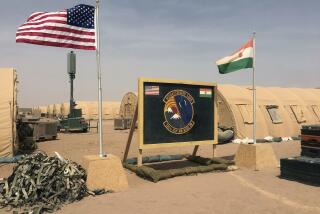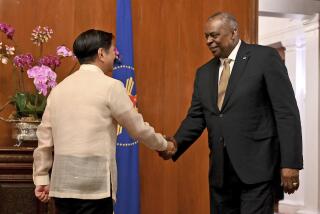Okinawa’s air base battle
- Share via
Okinawa. Site of the largest U.S. amphibious assault in the Pacific and the final major battle of World War II. Last territory to be handed back to Japanese control -- in 1972. And now, the first point of friction between the Obama administration and the 4-month-old government of Prime Minister Yukio Hatoyama.
As host to nearly three-quarters of the U.S. troops stationed in Japan, Okinawa residents have long felt that they shoulder more than their fair share. So it’s not surprising that the future of a U.S. Marine base has become a contentious issue. But if it is handled properly, it shouldn’t threaten the strategic relationship between the United States and Japan.
FOR THE RECORD:
Okinawa: A Jan. 30 editorial on plans to relocate a U.S. Marine Corps air base to the city of Nago said it is located on the southern end of the island. It is in the northeast. —
Since 1960, a treaty has granted U.S. armed forces use of Japanese land and facilities in return for protecting the country and responding in the event it is attacked. Understanding that keeping troops in highly populated areas can raise tensions, the United States agreed in 1996 to reduce its military footprint in Okinawa. But it took another decade to forge a deal to transfer 8,000 troops to Guam and move the U.S. Marine Corps’ Futenma air base from the crowded city of Ginowan to tiny Nago, on the southern end of the island.
The Pentagon is understandably frustrated. The 2006 agreement still had not been implemented in September, when voters booted out the party that had ruled Japan for half a century and elected Hatoyama’s Democratic Party of Japan, which, along with coalition members, promised to reconsider the deal. This week, Nago elected a new mayor who is opposed to the base, with its noisy helicopters and airstrip to be built on landfill in pristine waters. Hatoyama has pledged to reexamine all options and issue a decision in May.
Some politicians will try to place the base controversy in the context of the left-leaning Hatoyama’s desire to improve relations with China and the rest of Asia -- which they believe is leading to weakened relations with the U.S. That is a mistaken view, as the base issue was festering long before even Hatoyama’s predecessor began reaching out to Beijing. When it comes to China, Japan is only doing what the U.S. is doing: engaging with a major economic partner while keeping an eye on its military capabilities.
The way to protect the U.S.-Japan relationship is to recognize that in Japan, as elsewhere, all politics is local. U.S. Ambassador to Japan John V. Roos took a step in that direction with a speech Friday advocating for the Nago deal, but pledging to make the base environmentally and economically friendly. U.S. officials must continue to press the case with the Japanese people. Otherwise, come up with a Plan B.
More to Read
Sign up for Essential California
The most important California stories and recommendations in your inbox every morning.
You may occasionally receive promotional content from the Los Angeles Times.













